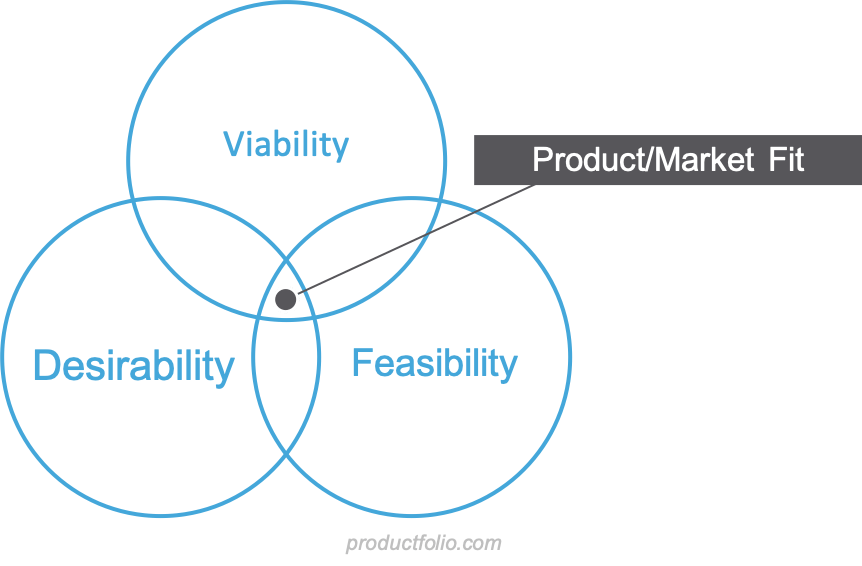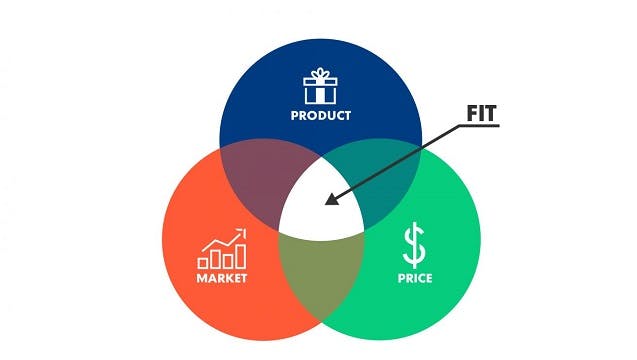I. Introduction
Explanation of Product Market Fit
Product-market fit is a term used in the startup industry to describe the point at which a product satisfies the needs of its target market. It is a critical milestone for any startup, as it signifies that the product has achieved a level of validation from customers and is generating sustainable revenue. In essence, product-market fit is the ultimate goal for any startup—to create a product that is in high demand and generates significant revenue.
Achieving product-market fit requires a deep understanding of the target customer, their pain points, and their willingness to pay for a solution. It also requires continuous testing, iterating, and refining of the product until it reaches a point where it clearly meets the needs of the target market. Startups risk wasting time and resources on a product that will fail and struggle to attract and retain customers if it lacks product-market fit.
The image below illustrates this concept, where the intersection between the product and market needs represents the ideal product-market fit.

A strong product-market fit is crucial for the success of a business, as it can lead to increased customer satisfaction, loyalty, and revenue. It requires a deep understanding of the target market and continuous feedback and iteration to ensure that the product continues to meet their evolving needs.
Importance of Product Market Fit for startups
Product-market fit is the process of ensuring that a product meets the needs of its target market. It is crucial for startups because it determines whether the product has the potential to meet the demands of the market and generate revenue. A product that achieves market fit has demonstrated that it solves a real problem, resonates with the target customers, and meets their needs in a way that the competition does not. Ultimately, product-market fit is the foundation for long-term success in any market.
Here are some key reasons why product-market fit is important for startups:
Validates the product idea: Achieving product-market fit validates that the product idea has the potential to succeed in the market and meets the real need of the target customers.
Reduces customer acquisition cost: When a product has achieved product market fit, it resonates with the target audience and generates word-of-mouth referrals, reducing the cost of customer acquisition.
Increases customer retention: A product that meets the needs of the target market will have higher customer retention rates, leading to increased revenue and a more sustainable business model.
Helps to prioritize product development: Product market fit helps startups prioritize which features or enhancements to focus on in their product development roadmap, leading to more efficient use of resources.
Attracts investment: Investors are more likely to invest in startups that have achieved product market fit, as it demonstrates that the product has a strong market demand and is generating revenue.
Enables scaling: Once product market fit is achieved, startups can scale their operations with greater confidence, knowing that there is a strong demand for their product.
II. Understanding Your Market

Identifying your target audience
Identifying your target audience is a key component of achieving product-market fit. Without a clear understanding of who your target audience is, it is difficult to develop a product that meets their needs and resonates with them.
Here are some ways in which identifying your target audience can help you achieve product-market fit:
Focus on customer needs: By identifying your target audience, you can gain a better understanding of their pain points, needs, and preferences. This allows you to tailor your product development to meet their specific requirements better, increasing the likelihood of achieving product market fit.
Improve messaging and positioning: Knowing your target audience enables you to develop marketing messaging that speaks directly to them, addressing their specific pain points and needs. This can improve the effectiveness of your marketing campaigns and help you reach your target audience more effectively.
Reduce customer acquisition cost: By focusing on your target audience, you can develop targeted marketing campaigns that are more effective at reaching your ideal customer. This can help to reduce customer acquisition costs, as you are not wasting resources on marketing to people who are unlikely to be interested in your product.
Increase customer engagement and retention: By developing a product that meets the needs of your target audience, you are more likely to create satisfied customers who are more likely to engage with your brand and become loyal customers.
Analyzing competition
Analyzing the competition is an important part of achieving product-market fit. By understanding the strengths and weaknesses of your competitors, you can better position your product in the market and develop a product that meets the needs of your target audience.
Here are some ways in which analyzing the competition can help you achieve product-market fit:
Identify gaps in the market: By analyzing your competitors' products and services, you can identify gaps in the market that are not being addressed. This can provide an opportunity for you to develop a product that meets a specific need or solves a particular problem.
Develop a unique value proposition: By understanding what sets your product apart from the competition, you can develop a unique value proposition that resonates with your target audience. This can help you to differentiate your product and attract customers who are looking for something different.
Understand customer preferences: By analyzing your competitors' products and customer reviews, you can gain a better understanding of what customers like and dislike about similar products. This can help you to develop a product that addresses these preferences and stands out in the market.
Identify potential partners or collaborators: By analyzing the ecosystem of your competitors, you can identify potential partners or collaborators who may be able to help you achieve product-market fit more quickly or effectively.
Develop a pricing strategy: By understanding your competitors' pricing strategies, you can develop a pricing strategy that is competitive and appealing to your target audience.
Analyzing the competition is an essential step in achieving product-market fit. By understanding the strengths and weaknesses of your competitors, you can better position your product in the market and develop a product that meets the needs of your target audience.
III. Defining Your Product
Describing your product or service
Defining your product or service is a crucial part of achieving product-market fit. The way you describe your product or service can impact how potential customers perceive its value and how well it meets their needs.
Here are some tips for describing your product or service to achieve product-market fit:
Focus on the problem your product solves: Start by clearly identifying the problem your product solves. Describe the pain points and challenges that your target audience faces, and explain how your product addresses those needs.
Emphasize the benefits: Describe the benefits of your product or service in a way that resonates with your target audience. Explain how your product makes their lives easier, saves them time, or saves them money.
Use clear and concise language: Avoid using technical jargon or complex terminology. Use clear and concise language that is easy for your target audience to understand.
Provide social proof: If you have satisfied customers, share testimonials or case studies that demonstrate the value of your product. This can help build trust with potential customers and increase their likelihood of purchasing your product.
Highlight unique features: If your product has unique features that set it apart from the competition, be sure to highlight them. Explain why these features are important and how they benefit your target audience.
By focusing on the problem your product solves, emphasizing the benefits, using clear and concise language, providing social proof, and highlighting unique features, you can increase the likelihood that your product meets the needs of your target audience and resonates with them.
Identifying your unique selling proposition (USP)

Identifying your unique selling proposition (USP) is a crucial part of achieving product-market fit. Your USP is what sets your product apart from the competition and makes it compelling to your target audience.
Here are some tips for identifying your USP:
Understand your target audience: Before you can identify your USP, you need to understand your target audience. Who are they? What are their needs and pain points? What motivates them to purchase a product like yours?
Identify your competition: Research your competition and identify what they offer. This will help you understand how your product is different and what unique value it provides.
Analyze your strengths: What are your strengths as a company? Do you have any unique expertise or resources that set you apart from the competition? How can you leverage these strengths to create a unique product offering?
Identify your unique benefits: Consider the benefits of your product and how they compare to those of your competition. Are there any benefits that are unique to your product or that you offer in a different way?
Refine your message: Once you have identified your USP, refine your message so that it is clear and concise. Make sure that it resonates with your target audience and communicates the unique value that your product provides.
By understanding your target audience, analyzing your competition, identifying your strengths, identifying your unique benefits, and refining your message, you can create a product that is compelling to your target audience and that stands out in the market.
Creating a value proposition
Creating a strong value proposition is a crucial part of achieving product-market fit. "Value proposition" is a statement that describes the unique value that your product provides to your target audience.
Here are some tips for creating a compelling value proposition:
Identify your target audience: Before you can create a value proposition, you need to understand your target audience. Who are they? What are their needs and pain points? What motivates them to purchase a product like yours?
Identify the benefits of your product: Consider the benefits that your product provides to your target audience. How does it make their lives easier, save them time, or save them money?
Highlight your unique selling proposition: Your unique selling proposition (USP) is what sets your product apart from the competition. Identify what makes your product unique and how it provides value that is different from what the competition offers.
Be specific and clear: Your value proposition should be clear and specific. Use simple language and avoid using technical jargon or complex terminology.
Test and refine: Once you have created a value proposition, test it with your target audience. Gather feedback and use it to refine your message and make it more compelling.
Creating a value proposition is a critical step in achieving product-market fit. By identifying your target audience, highlighting the benefits of your product, highlighting your USP, being specific and clear, and testing and refining your message, you can create a compelling value proposition that resonates with your target audience and helps you stand out in the market.
IV. Achieving Product Market Fit

Key indicators of Product Market Fit
There are several key indicators that can help you determine whether or not your product has achieved product-market fit.
Here are some of the most important indicators to look for:
Customer Acquisition Cost (CAC): If your CAC is decreasing over time while your revenue is increasing, this is a strong indication that you have achieved product market fit. This means that your marketing efforts are becoming more efficient and that your product is resonating with your target audience.
Customer Retention Rate: If your customer retention rate is high, this is a good sign that your product is meeting the needs of your customers. If customers are sticking around and continuing to use your product, this means that they are finding value in it.
Customer Satisfaction: High customer satisfaction is a strong indicator of product market fit. If customers are satisfied with your product, they are more likely to recommend it to others and become loyal customers.
Referral Rate: If your customers are referring your product to others, this is a good indication that you have achieved product market fit. Referrals are a powerful form of marketing and can help you acquire new customers at a low cost.
Revenue Growth: If your revenue is growing consistently over time, this is a good indication that you have achieved product market fit. This means that you have found a product-market fit and that you are able to generate revenue from it.
By monitoring these indicators, you can determine whether or not your product is meeting the needs of your target audience and resonating with them.
Measuring and tracking success
Measuring and tracking success in achieving product-market fit is important for startups to ensure that they are making progress towards their goals.
Here are some key steps to help measure and track success in achieving product-market fit:
Define Success Metrics: Identify and define the key metrics that are most important for your business. These metrics could include revenue, customer acquisition cost, customer retention rate, conversion rate, customer satisfaction, referral rate, and more.
Collect Data: Collect data on your success metrics regularly, using tools such as Google Analytics, CRM software, surveys, and other analytics tools. This will help you track progress over time and identify areas that need improvement.
Analyze Data: Analyze the data you have collected to identify patterns, trends, and areas for improvement. Look for changes in metrics over time and compare them to industry benchmarks and competitors to gain context and perspective.
Adjust Strategies: Based on your analysis, adjust your strategies as needed to optimize your approach and better meet the needs of your target audience. This might involve adjusting your messaging, improving your product features, or targeting different segments of your audience.
Test and Iterate: Test your strategies and iterate on your approach to continually improve and optimize your efforts. This might involve A/B testing, user testing, or other methods to gain insights and make data-driven decisions.
By following these steps, startups can more effectively measure progress and make informed decisions to drive growth and achieve product-market fit.
V. Conclusion
In conclusion, product-market fit is crucial for the success of startups. It ensures that startups are developing products that meet the needs of their target audience and that they are focusing their resources on the right areas to drive growth. By achieving product market fit, startups can reduce marketing costs, increase customer loyalty, and improve their brand reputation.
However, achieving product-market fit is not a one-time event but an ongoing process that requires continuous refinement and iteration. Startups must be willing to listen to their customers, analyze their data, and adjust their strategies as needed to improve their products and better meet the needs of their target audience.
Overall, product-market fit should be a top priority for startups, as it can be the difference between success and failure. By understanding their target audience, analyzing their competition, creating a compelling value proposition, and continuously tracking their success metrics, startups can increase their chances of achieving product-market fit and driving growth and success for their business.
Was this article helpful? If yes, please follow me for more interesting articles on products, product management, tech product reviews, and much more.
Don't forget to give me a like and share; you might be helping someone!
